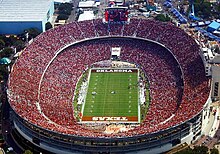Parks
Dallas maintains and operates 406 parks on 21,000 acres (85 km2) of parkland.The city's parks contain 17 separate lakes, including White Rock and Bachman lakes, spanning a total of 4,400 acres (17.81 km2). In addition, Dallas is traversed by 61.6 miles (99.1 km) of biking and jogging trails, including the Katy Trail, and is home to 47 community and neighborhood recreation centers, 276 sports fields, 60 swimming pools, 232 playgrounds, 173 basketball courts, 112 volleyball courts, 126 play slabs, 258 neighborhood tennis courts, 258 picnic areas, six 18-hole golf courses, two driving ranges, and 477 athletic fields.[136]
Fair Park
Dallas' flagship park is Fair Park. Built in 1936 for the Worlds Fair and the Texas Centennial Exposition, Fair Park is the world's largest collection of Art Deco exhibit buildings, art, and sculptures; Fair Park is also home to the State Fair of Texas, the largest state fair in the United States.
Hall of State building in Fair Park.
Klyde Warren Park
Named after Klyde Warren, the young son of billionaire Kelcy Warren, Klyde Warren Park was built above Woodall Rodgers Freeway and connects Uptown and Downtown, specifically the Arts District.Klyde Warren Park is home to countless amenities including: an amphitheater, jogging trails, children's park, My Best Friend's Park (dog park), a putting green, croquet, ping pong, chess, an outdoor library, and two restaurants: Savor and Relish. Food trucks give hungry people another option of dining and are lined along the park's downtown side.
There are also weekly planned events including yoga, zumba, skyline tours, Tai Chi, and meditation.[137]
Klyde Warren park is home to a free trolley stop on Olive St., which riders can connect to Downtown, McKinney Avenue, and West Village.
Turtle Creek Park
Built in 1913, Turtle Creek Park is a 23.7 acre linear park[138] in-between Turtle Creek and Turtle Creek Boulevard in the aptly named Turtle Creek neighborhood.Archaeological surveys discovered dart points and flint chips dating 3,000 years to 1,000 B.C. This site was later discovered to be home to Native Americans who cherished the trees and natural spring water. The park is across Turtle Creek from Kalita Humphreys Theater, designed by Frank Lloyd Wright.
Lake Cliff Park
Opened on July 4, 1906, Lake Cliff Park was called "the Southwest's Greatest Playground". The park was home to an amusement park, a large pool, waterslides, the world's largest skating rink, and three theaters, the largest being the 2,500-seat Casino Theater. After the streetcar bridge which brought most of the park visitors collapsed, Lake Cliff Park was sold. The Casino Theater moved and the pool was demolished after a polio scare in 1959. The pool was Dallas' first municipal pool.[139]Reverchon Park
In 1935, Dallas purchased 36 acres (15 ha) from John Cole's estate to develop Reverchon Park.[140] Reverchon Park was named after botanist Julien Reverchon, who left France to live in the La Reunion colony in present-day West Dallas. Reverchon Park was planned to be the crown jewel of the Dallas park system and was even referred to as the "Central Park" of Dallas. Improvements were made throughout the years including the Iris Bowl, picnic settings, a baseball diamond, and tennis courts. The Iris Bowl celebrated many Greek pageants, dances, and other performances. The Gill Well was installed for nearby residents and drew people all across Texas who wanted to experience the water's healing powers.[141] The baseball diamond was host to a 1953 exhibition game for the New York Giants and the Cleveland Indians.[142]Trinity River Project
As part of the ongoing Trinity River Project, the Great Trinity Forest, at 6,000 acres (24 km2), is the largest urban hardwood forest in the United States and is part of the largest urban park in the United States.[31] The Trinity River Audubon Center is a new addition to the park. Opened in 2008, it serves as a gateway to many trails and other nature viewing activities in the area. The Trinity River Audubon Center is the first LEED-certified building constructed by the City of Dallas Parks and Recreation Department.
View of Turtle Creek and Turtle Creek Boulevard from a Katy Trail overpass.
Katy Trail
Named after its former railroad name, the Missouri-Kansas-Texas Railroad (or "MKT" Railroad), the 3.5 mile stretch of railroad was purchased by the City of Dallas and transformed into the city's premier trail. Stretching from Victory Park, the 30-acre Katy Trail passes through the Turtle Creek and Knox Park neighborhoods and runs along the east side of Highland Park. The trail currently terminates at Central Expressway, however extensions are under way to extend the trail to the White Rock Lake Trail in Lakewood.[139]In 2015, the Katy Trail was awarded "Best Public Place" from the Urban Land Institute.[143]













